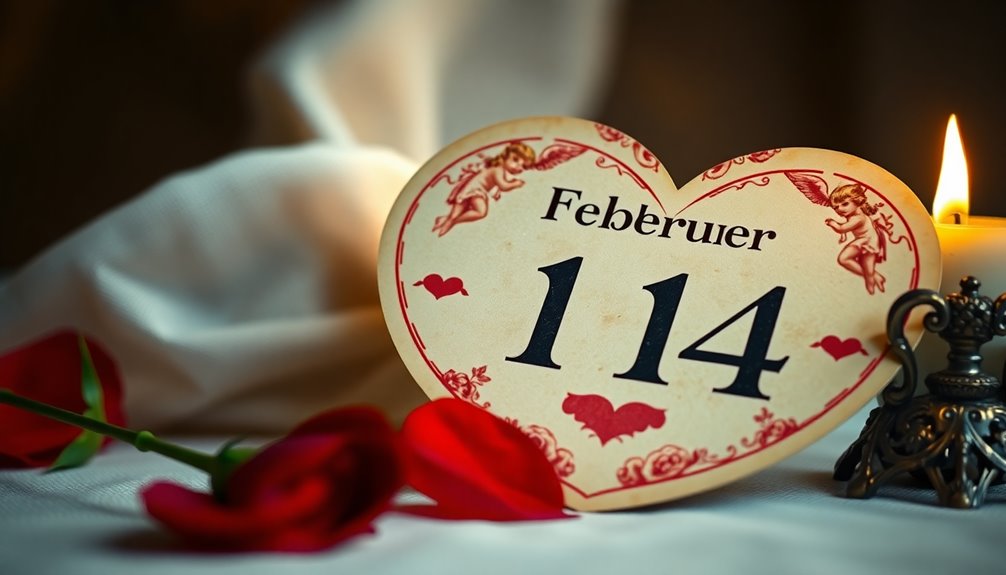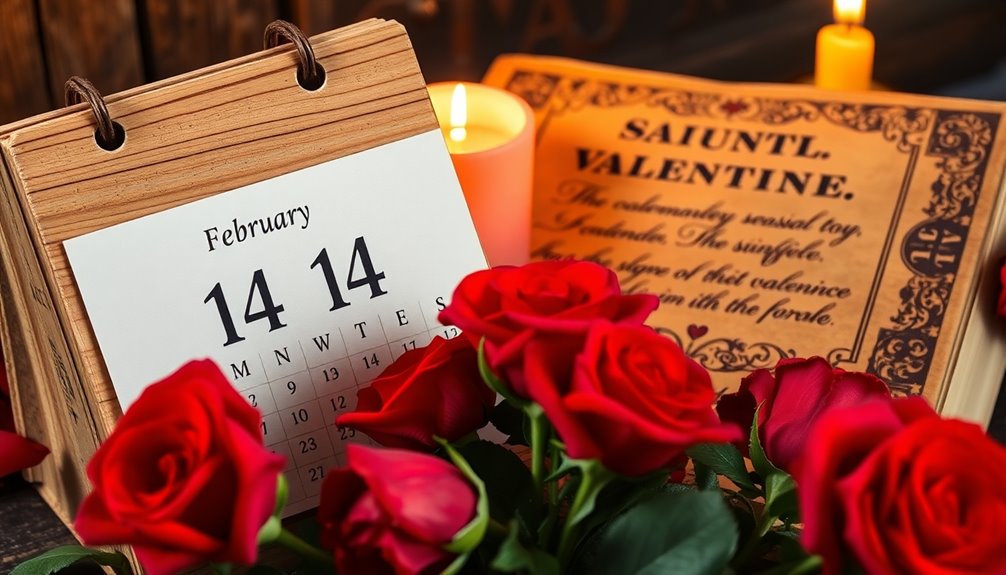Valentine's Day, celebrated on February 14, has roots in the ancient Roman festival Lupercalia, which focused on fertility. The day honors St. Valentine, a martyr known for his romantic legends, such as secretly marrying soldiers. Over time, the holiday evolved from fertility rites to a celebration of love and friendship. With the rise of commercialization in the 19th century, it became a day for exchanging cards and gifts. Find out how these traditions continue to shape our expressions of love.
Key Takeaways
- Valentine's Day has origins in the ancient Roman festival Lupercalia, focused on fertility and pairing off partners.
- The day commemorates St. Valentine, a martyr executed on February 14, linked to themes of love.
- St. Valentine is associated with legends of secret marriages and heartfelt letters, reinforcing romantic connections.
- The holiday evolved in the medieval period, with Geoffrey Chaucer and Shakespeare promoting its association with romantic love.
- Valentine's Day became commercialized in the 19th century, transforming into a consumer holiday centered on gifts and cards.

As you celebrate Valentine's Day each year, you mightn't realize its fascinating history that stretches back to ancient Rome. This beloved holiday has roots in the ancient Roman festival of Lupercalia, held in mid-February, which was all about fertility rites and pairing off partners. Lupercalia involved feasting and pairing off partners aimed to promote fertility and love connections among participants.
As Christianity spread, Pope Gelasius I outlawed Lupercalia in the 5th century, possibly paving the way for St. Valentine's Day to take its place.
While Lupercalia was a wild celebration focused on fertility, the day we now associate with love and romance evolved from honoring a martyred saint. The exact origins remain murky, with historical gaps leaving us with more questions than answers.
You might be surprised to learn that the name "Valentine" likely refers to two martyrs executed by Emperor Claudius II on February 14, each with their own unique stories. One popular legend tells of St. Valentine writing a heartfelt letter signed "From your Valentine" before his execution, a gesture that transformed into the romantic custom we cherish today.
Another tale suggests he defied the emperor by secretly marrying soldiers, further embedding love into the holiday's legacy. Despite the uncertainty surrounding his life, St. Valentine is still recognized as a saint, although his feast day was removed from the Catholic calendar in 1969.
The celebration of Valentine's Day truly began to take shape during the medieval period, thanks in part to Geoffrey Chaucer and later William Shakespeare, who linked the day with romantic love.
By the mid-19th century, the Industrial Revolution enabled mass production of cards and heart-shaped chocolates, making them accessible to the public and commercializing the holiday.
Today, Valentine's Day symbolizes love and friendship worldwide, celebrated through gifts, cards, and various cultural traditions that continue to evolve, reflecting our ever-changing views on love.
Frequently Asked Questions
What Are Some Popular Valentine's Day Traditions Around the World?
Valentine's Day traditions vary globally, and you'll find unique ways people celebrate love.
In Denmark, you might receive white snowdrops, while in Finland, it's a day for friendship gifts.
Germans often exchange heart-shaped ginger biscuits, and in the Philippines, mass weddings take place.
South Koreans have an interesting twist, with women giving chocolates on February 14 and men returning the favor on White Day.
Each culture adds its special touch to this beloved holiday!
How Did Valentine's Day Become Associated With Romantic Love?
Imagine the flutter of hearts as you exchange sweet notes and roses.
Valentine's Day became linked to romantic love through the enchanting words of Geoffrey Chaucer, who penned about lovebirds choosing mates on this very day.
Over centuries, noble gestures of affection transformed simple notes into beloved "valentines."
As the holiday evolved, it blossomed into a celebration of love, where you now find chocolates, cards, and heartfelt connections filling the air.
Are There Any Alternative Celebrations for Valentine's Day?
Absolutely! If you're looking for alternative celebrations on Valentine's Day, consider hosting a Friendship Day, where you spend quality time with friends or express gratitude.
You could also dedicate the day to self-care, embracing a Self-Love Day. Volunteering together or engaging in fun activities like cooking or hiking can strengthen bonds.
These alternatives promote inclusivity and allow everyone to celebrate love in diverse, meaningful ways beyond traditional romantic gestures.
What Are Common Gifts Exchanged on Valentine's Day?
Valentine's Day gifts are like sweet whispers of love exchanged between hearts. You might find yourself gifting candy, greeting cards, or vibrant flowers, with red roses stealing the show.
An evening out can spark romance, while jewelry often dazzles eyes.
Don't forget your furry friends—pet gifts are on the rise! Whether you're splurging or keeping it simple, these tokens of affection help you express your feelings in delightful ways.
How Do Different Cultures Celebrate Love and Affection?
Different cultures celebrate love and affection in unique ways.
In France, you might enjoy a romantic dinner, while in Japan, women often gift chocolates to men.
In South Korea, there's a similar tradition, with men reciprocating on White Day.
In the Philippines, mass weddings take place on Valentine's Day, and in Denmark, you could receive handmade cards with snowdrops.
Each culture adds its own flavor to expressing love and connection, making it a wonderful global celebration.
Conclusion
So, as you rush to buy overpriced chocolates and wilted roses this Valentine's Day, remember the real Saint Valentine—a martyr whose love story was anything but commercial. Instead of just swiping your card, why not honor the spirit of genuine love he championed? After all, nothing says "I care" like a last-minute gift that'll be forgotten by next week. Let's keep the spirit alive, one heart-shaped box at a time, shall we? Happy Valentine's Day!










